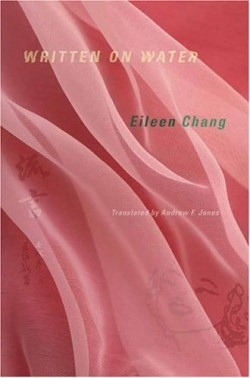
Written on Water
The author, a novelist, wrote these sparkling, discursive essays during Japan’s brutal World War II occupation of Shanghai. Readers are likely to consider her a carefree commentator, writing about home, siblings, fathers (and their concubines), literature, the performing arts, fashion, education, shopping and much else, often contrasting contemporary and traditional China. Only one essay focuses on the horrors of the occupation.
As most readers have minimal or no knowledge of life and literature in wartime Shanghai, Nicole Huang’s excellent introduction is especially valuable: Chang emerges as a multifaceted essayist, aware of tradition while embracing modernity; concerned to capture the underlying pulse of life, offering a haven in troubled times. Thus her focus on an internal world of gentler times and richer memories rather than on an external world of wartime problems. Huang notes that the author’s quest for success brought her perhaps too close to the Chinese political leadership, which was much criticized for being overly collaborative.
The book’s title hints at the ephemerality of life and thought in wartime, and the rewards of examining the self, familiar institutions, and life as people live it. It also hints at the quicksilver immediacy of Chang’s style and her ability to develop flights of thought and fancy from commonplace situations. Her longer pieces are impressive, and “Writing of One’s Own” demonstrates her range: in analyzing her novel Chained Links, she considers both literary theory and content; not only the mighty but also the humble (“They lack tragedy; all they have is desolation”) contribute to the true record of troubled times. She then deftly comments on the changing focus of Tolstoy’s War and Peace, and works in a note on the use of archaic diction in contemporary fiction.
“Unforgettable Paintings” is equally rich, moving through classic portrayals of the Virgin Mary to mistresses and geishas by painters including Gauguin and classic Japanese artists, before considering the evocative powers of Chinese landscape painting. Likewise, her essays on the Peking Opera and dance bristle with insights.
“Notes on Apartment Life,” addressing defective boilers, plumbing, pianists, and other torments of daily life, will delight any high-rise denizen, while the dazzling miscellany of shorter pieces offer insights on such topics as the pains of adolescence and school, the joys of shopping, the deficiencies of umbrellas, the appeal of fashion, police brutality, differing lifestyles in Shanghai and Hong Kong, and more. Invariably, Chang catches the moment and crystallizes the experience; with her preferred “forthright simplicity” and whimsical line drawings, she knows how to beguile her readers.
Only a person well versed in Chinese can assess the technical virtues of the translation, but Andrew Jones (of the University of California) has certainly presented Chang’s remarkable work in fluid and pleasing English.
Reviewed by
Peter Skinner
Disclosure: This article is not an endorsement, but a review. The publisher of this book provided free copies of the book to have their book reviewed by a professional reviewer. No fee was paid by the publisher for this review. Foreword Reviews only recommends books that we love. Foreword Magazine, Inc. is disclosing this in accordance with the Federal Trade Commission’s 16 CFR, Part 255.
